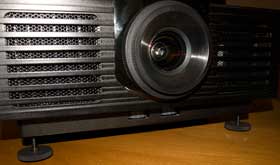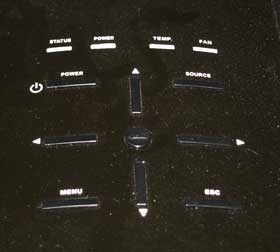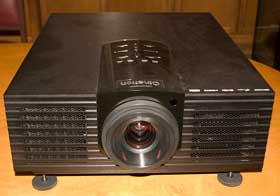Appearance
Not much new hen it comes to touring the physical layout of the HD700. To the eye, it's pretty much a replay of the PT-AE2000U, and PT-AE3000U projectors. There are very few differences between them. Overall, the projector is a medium sized, flat finished, dark gray, rectangular box. Definitely no styling awards, except, perhaps for industrial efficiency. In a dark room, you won't be looking at the projector and that's what counts.
The noteworthy change to the Cinetron HD700 projector is the addition of a pair of 12 volt triggers on the input panel.
From the front, the HD700 has a centered 2:1 motorized zoom lens, which is almost completely recessed (except for the lens ring). Also in the front, is an infra-red sensor for the remote control. Below are two screw thread adjustable front feet.
Moving to the top of the Cinetron HD700, all you will find are two recessed, manual lens throw adjustment "wheels", one for vertical and one horizontal. Details on lens shift range will be found in the Lens shift section below.
Looking from the rear of the HD700, there is a spring released door on the left side, which reveals, when open, the control panel of the HD700. The control panel is a very standard affair.
The projector vents hot air out the vents in the front, and takes in air from the vents in the rear.
That takes us to the back of the Panasonic projector, where you will find all the computer's inputs and outputs.
Cinetron HD700 Control Panel
The Cinetron HD700 has a large control panel right on the top, in that shiny area. It has four really bright indicator lights (fortunately, settings options allow them to be turned off when viewing). (This HD700 defaulted to that position).
Right behind the indicators (status, power, temp, and fan), is the Power switch (left side looking from the back of the projector), and across from it, the Source select button
There are the usual 4 navigation arrow buttons in a diamond layout, with an Enter button in the dead center. To the left and right of the down arrow button are the remaining two. On the left, is the Menu button, and the matching ESC (escape) button (which moves you back up a level in the menus) is on the right.
All considered a nice large, easy to use layout. That is, of course, until you mount the projector and use the remote. Still it was a good layout, as I often change settings right from the control panel. (That's especially true for this projector, as its remote has limited range (discussed below).
Input/Output
The image below shows the input/output panel of the Cinetron HD700. If you are looking at the projector, from the rear, the inputs run along the right side of the projector, at the bottom. The power receptacle can (just) be seen on the far left of the image.
In addition to the pair of HDMI 1.3 inputs (middle) there is a computer input to the immediate left, and an RS232 serial port (for "command and control") to their right. (I always wish for 3 HDMI's but, few provide them.) The computer input should be able to alternately be used as a 2nd component video input (with the appropriate cabling).
To the left (towards the back) of the projector next comes the serial port (DIN plug) and the single RCA jack for composite video. Finally furthest back are the three color coded RCA jacks for the primary component video input.
At the front, are two 12 volt screen triggers, they could be used for controlling a screen or maybe an anamorphic lens and sled. It's always nice to see screen triggers, (though few use them).
In this day and age, most home theater projectors have a single trigger, a few have two, and some have none. While convenient, they are generally not critical, as the types of devices normally controlled, like lowering or raising a motorized screen, triggering an anamorphic lens sled, a screen masking system, or even just powering on and off other components, can be controlled with 3rd party "universal" remotes, room control systems, etc. In other words, definitley a nice touch, but one most people won't need to have, and can come up with work arounds, if need be.





